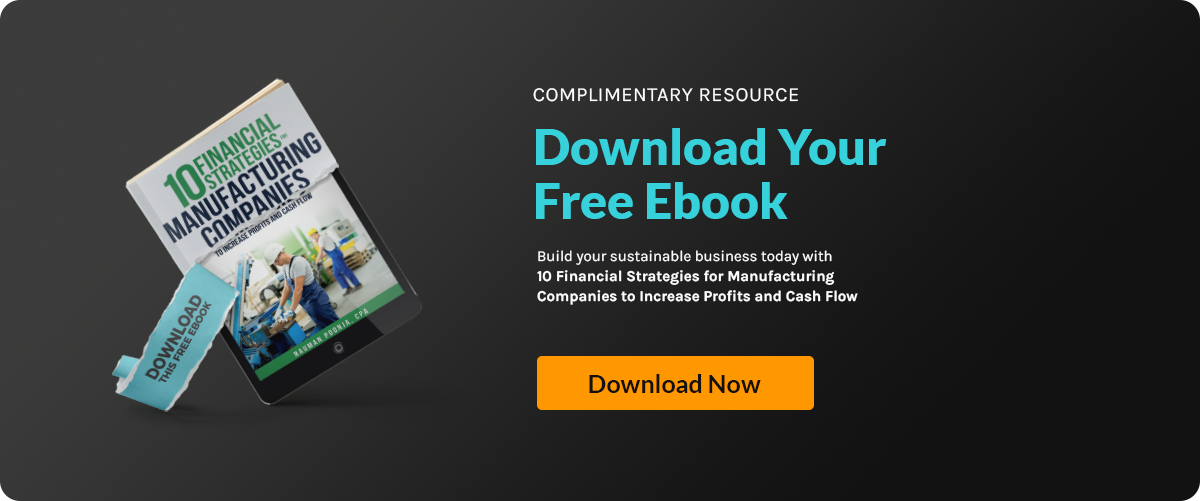For founders, growth starts and ends with cash. You can have steady sales, expanding operations,...
Raising Capital: A Founder’s Complete Financial Readiness Checklist

Raising capital can fuel your next stage of growth—but only if your financial foundation is solid. Whether you’re planning to expand production, upgrade equipment, or enter new markets, investors will judge your business not just on potential, but on financial discipline and visibility.
For founders, capital readiness isn’t about having the best pitch—it’s about having the clearest numbers. Before any funding conversation, your books, forecasts, and compliance systems must show that your company runs on data, not guesswork.
This guide outlines everything founders need to prepare before raising capital—from financial statements and forecasting to compliance and investor confidence.
Why Financial Readiness Matters Before Raising Capital
Founders often focus on storytelling when seeking funding. But investors rely on numbers to verify that story. Clear, consistent financials demonstrate competence, reduce perceived risk, and speed up due diligence.
A company with organized statements, transparent cash flow, and well-defined projections sends one message: we know how to manage growth.
The difference between a founder who secures funding and one who doesn’t often comes down to the level of financial clarity. That clarity begins with following a disciplined financial management control process.
Step 1: Audit Your Financial Statements
The foundation of capital readiness is accuracy. Before approaching investors, your financial statements must reflect the full picture of your company’s health.
1. Profit and Loss Statement (Income Statement)
Shows revenue, expenses, and profit over time. Investors use this to assess operational performance. Review your profit and loss statement to ensure revenue recognition, cost categories, and expense trends are clearly presented.
2. Balance Sheet
Shows assets, liabilities, and equity at a point in time. It reveals how much your company owns and owes, as well as retained earnings.
3. Cash Flow Statement
Tracks money coming in and out. Investors want to know how efficiently you convert revenue into cash. A strong grasp of cash flow forecasting proves your company can stay solvent even during rapid growth.
Ensure these statements follow consistent accounting principles—such as GAAP—to build trust with auditors and investors alike.
Step 2: Strengthen Your Accounting Infrastructure
Investors look beyond financial results—they assess how reliable your systems are. Manual bookkeeping or inconsistent data entry raises red flags.
Modern, automated accounting platforms eliminate those concerns. Integrating tools that connect operations, inventory, and payroll improves accuracy and efficiency.
Implementing accounting automation not only streamlines processes but also ensures that financial data is always audit-ready, freeing your team to focus on analysis instead of chasing spreadsheets.
If you operate across multiple production sites, centralizing everything within an ERP system helps align your financial and operational data under one dashboard.
Step 3: Establish Clear Forecasts and Financial Models
Investors don’t just invest in what you’ve achieved—they invest in what you can predict.
Forecasting and modeling demonstrate your understanding of market dynamics, pricing strategy, and cost control. Together, they form the backbone of forward-looking financial planning.
-
Forecasting projects future revenue and expenses based on trends.
-
Financial modeling tests multiple “what-if” scenarios—how profit margins shift if material prices rise, or how additional debt affects cash flow.
Understanding the relationship between the two is vital. Learn how financial modeling and forecasting work together to support data-driven decision-making and investor confidence.
Step 4: Build a Strong Cash Flow Strategy
Cash flow remains the most scrutinized financial metric during funding rounds. Even profitable businesses can collapse under poor liquidity management.
Investors want proof that your cash position can sustain operations while scaling. Your cash flow management plan should highlight:
-
How cash inflows and outflows align with your forecast
-
How you manage working capital and inventory
-
Contingency plans for late receivables or unexpected expenses
Demonstrating consistent liquidity reassures investors that your company can absorb growth without constant refinancing.

Step 5: Define and Track Key Financial KPIs
Investors don’t have time to interpret dozens of metrics—they care about a handful that reflect profitability, efficiency, and scalability.
Common manufacturing KPIs include:
- Gross Profit Margin – Measures production efficiency
- Operating Cash Flow Ratio – Indicates liquidity strength
- Inventory Turnover – Tracks how quickly stock converts to sales
- Return on Invested Capital (ROIC) – Evaluates capital efficiency
These indicators should align with those found in your financial KPI dashboard. Consistent, data-backed KPIs show that your management team monitors performance as carefully as investors will.
Step 6: Document Your Cost Structures
A deep understanding of your cost structure—both fixed and variable—is essential. It tells investors how your business scales.
When founders understand their cost of goods sold, labor allocation, and overhead, they can explain how each production change impacts margins.
An optimized cost system not only improves profitability but also reduces investor risk. Manufacturing companies that refine inventory efficiency through cost optimization are more likely to sustain growth after funding.
Step 7: Review Your Capital Structure
Your current mix of debt and equity affects investor appetite. A company already carrying heavy liabilities might struggle to attract new capital.
Evaluate your balance sheet to ensure leverage is reasonable and that retained earnings are reinvested strategically. You can analyze options through a debt vs. equity comparison to decide how best to structure future funding.
Maintaining transparency around capital sources builds trust during investor negotiations.
Step 8: Build Scalable FP&A Processes
Financial Planning and Analysis (FP&A) ties together forecasting, budgeting, and performance review. A mature FP&A process signals that your company can manage growth responsibly.
FP&A bridges strategy and execution by linking data from across your organization—sales, operations, and finance—to produce reliable projections. This approach is detailed in FP&A Explained: The Missing Piece in Every Growing Company’s Strategy.
Investors value companies with formal FP&A frameworks because they prove that leadership understands not only how to make money, but how to sustain it.
Step 9: Prepare for Due Diligence
Once an investor shows interest, the diligence process begins. This is where every assumption is tested—numbers, contracts, projections, and compliance.
Having clean, reconciled financials accelerates this stage. Make sure:
- Tax filings match reported revenue
- Outstanding debts and leases are clearly listed
- Historical data aligns with projections
- Corporate documents are accessible and current
Companies with automated systems, standardized reporting, and strong audit trails—like those built through financial auditing processes in manufacturing accounting—typically pass due diligence with fewer roadblocks.
Step 10: Create a Clear Use of Funds Plan
Investors want to know exactly how their money will be used. A vague plan is a warning sign.
Outline where capital will go—product development, marketing, equipment upgrades, or working capital—and connect each allocation to measurable outcomes.
Tie your spending plan to your strategic capital allocation framework so that every dollar raised contributes directly to long-term value creation.
Step 11: Refine Your Story Through Data
A strong financial foundation is only half of capital readiness. The other half is communication. Your financials should tell a story of growth that feels inevitable because the data supports it.
When every statement, model, and forecast points toward disciplined expansion, your narrative gains credibility.
That alignment between vision and verification is what turns an investor’s interest into a signed check.
Common Red Flags That Scare Investors Away
-
Disorganized Financials – Inconsistent reporting formats, missing statements, or unexplained line items.
-
Unrealistic Forecasts – Growth projections that don’t reflect market trends or historical performance.
-
Weak Cash Flow Management – Operating on thin liquidity without contingency planning.
-
Unclear Profit Margins – Inability to explain gross or net margins by product line.
-
Overreliance on Manual Systems – Signals operational inefficiency and potential errors.
Investors want scalable, not fragile. Clean financials eliminate doubts before they arise.
Step 12: Consider Expert Financial Support
Many founders handle accounting themselves in the early days—but as complexity increases, expert support becomes essential. Outsourcing to professionals brings precision and frees leadership to focus on growth strategy.
Partnering with outsourced accounting services ensures accuracy, compliance, and insight while controlling overhead.
For strategic-level guidance without hiring a full-time executive, companies often rely on fractional CFOs in manufacturing. They build investor-ready systems, refine forecasts, and align your story with investor expectations.
The Final Review Before Investor Outreach
Before you pitch, make sure your finance package includes:
-
Three years of audited financial statements
-
Twelve-month rolling forecast
-
Updated balance sheet and cash flow analysis
-
KPI dashboard summarizing operational performance
-
Use-of-funds plan with ROI breakdowns
Once this foundation is in place, your pitch deck will carry far more weight—because it’s supported by evidence.
The Bottom Line
Investors fund clarity. When your financial systems, models, and forecasts all align, you’re no longer asking for money—you’re offering a partnership built on trust and transparency.
A founder who masters capital readiness can walk into any investor meeting with confidence, knowing every number tells the same story: this company is built to grow. Ready to prepare your financials for your next funding round?
Contact Accounovation to build investor-ready systems that strengthen your numbers, streamline reporting, and position your company for scalable growth.







